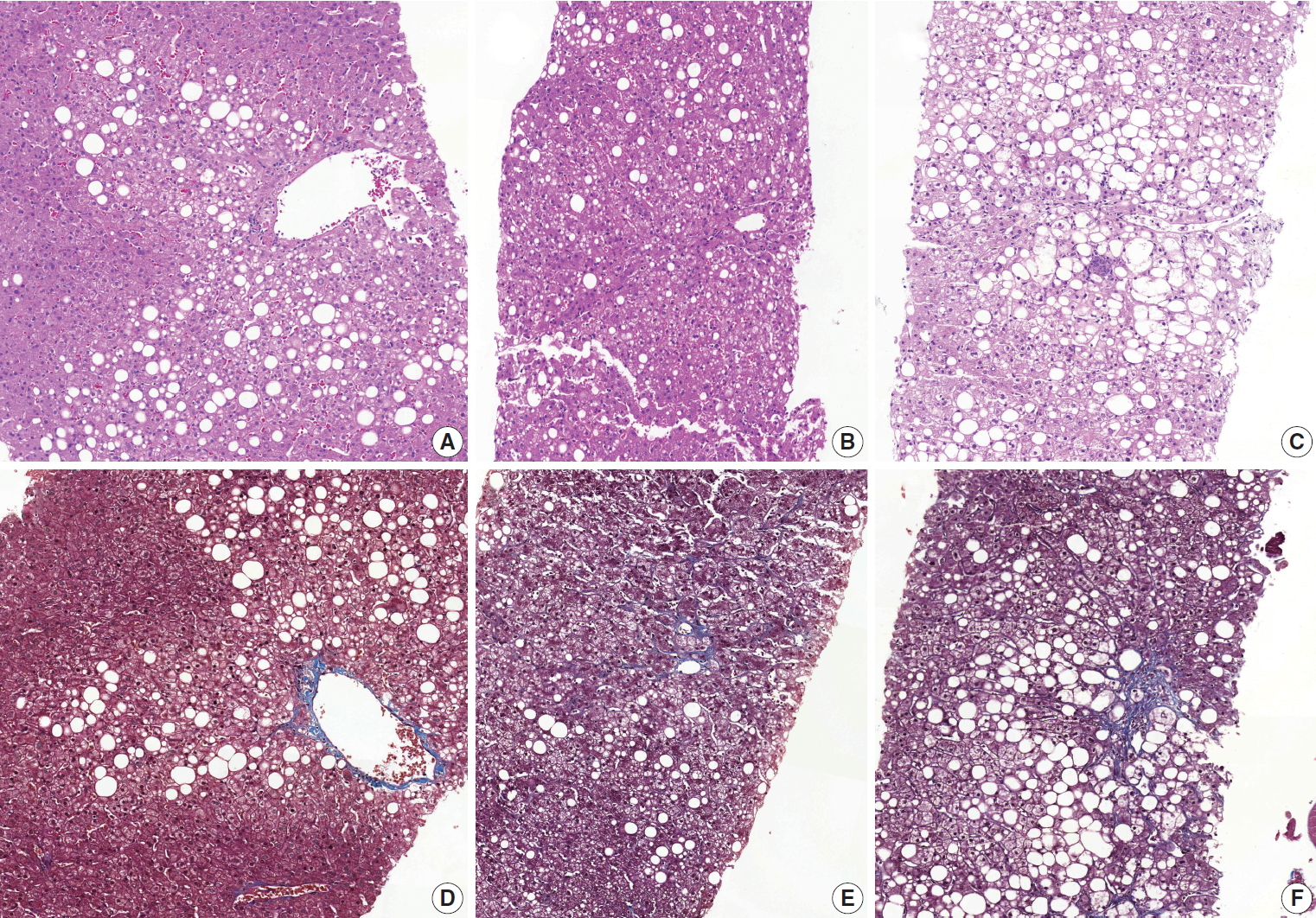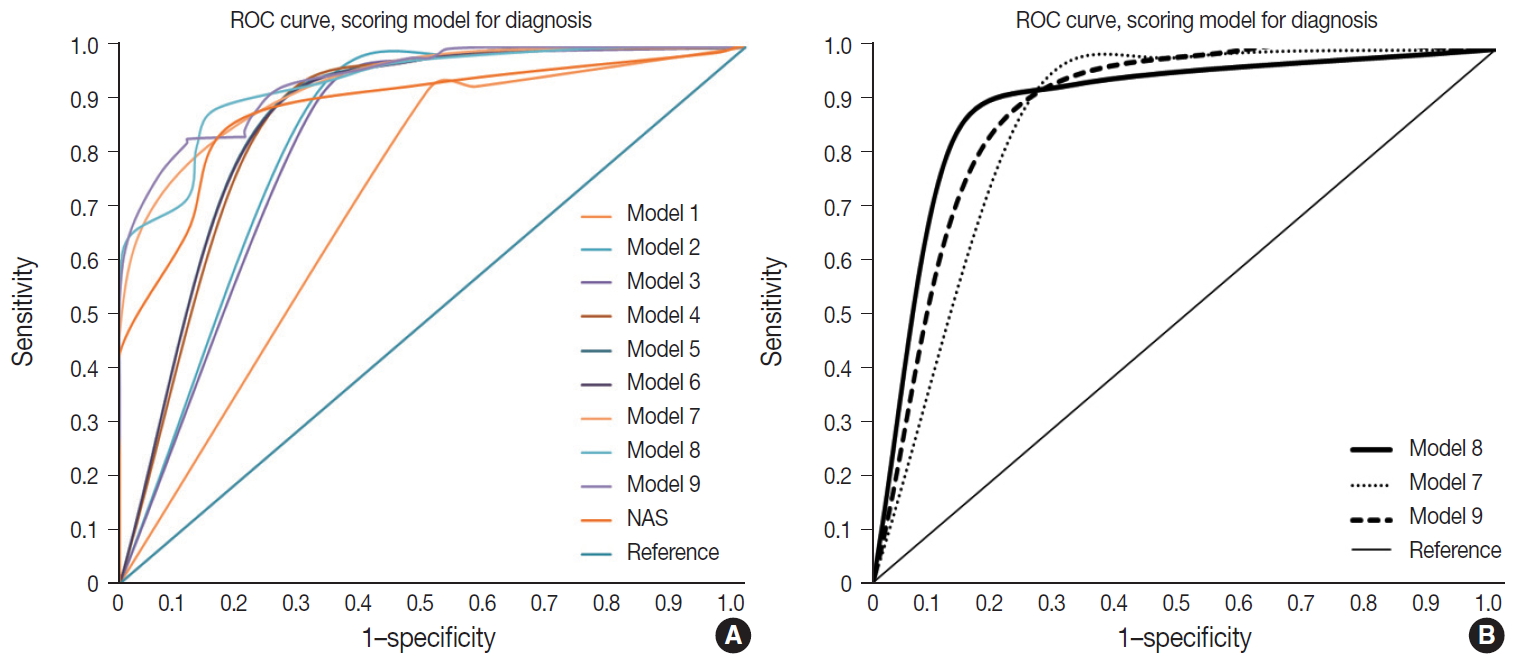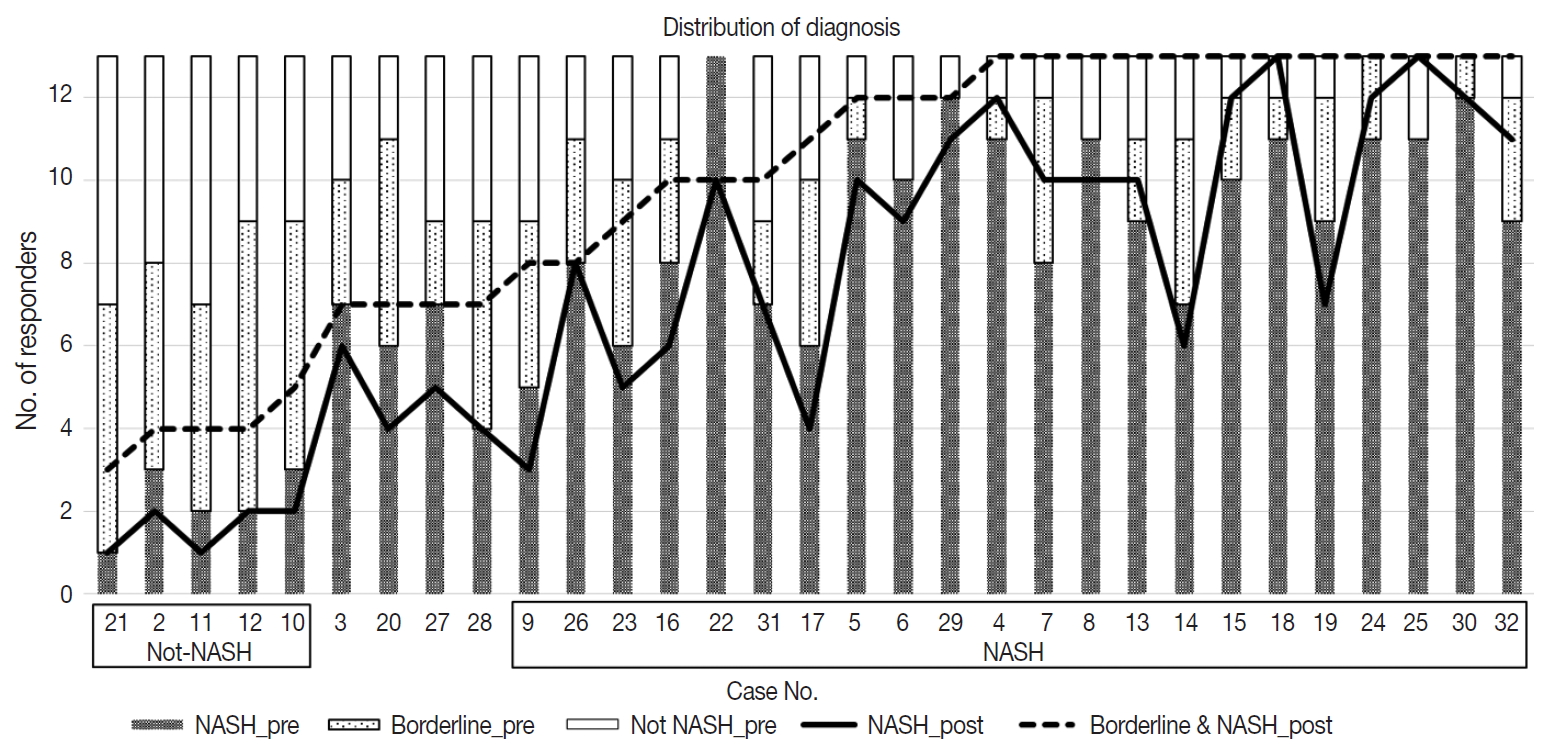Articles
- Page Path
- HOME > J Pathol Transl Med > Volume 54(3); 2020 > Article
-
Original Article
A scoring system for the diagnosis of non-alcoholic steatohepatitis from liver biopsy -
Kyoungbun Lee1,2
 , Eun Sun Jung1,3
, Eun Sun Jung1,3 , Eunsil Yu1,4
, Eunsil Yu1,4 , Yun Kyung Kang1,5
, Yun Kyung Kang1,5 , Mee-Yon Cho1,6
, Mee-Yon Cho1,6 , Joon Mee Kim1,7
, Joon Mee Kim1,7 , Woo Sung Moon1,8
, Woo Sung Moon1,8 , Jin Sook Jeong1,9
, Jin Sook Jeong1,9 , Cheol Keun Park1,10
, Cheol Keun Park1,10 , Jae-Bok Park1,11
, Jae-Bok Park1,11 , Dae Young Kang1,12
, Dae Young Kang1,12 , Jin Hee Sohn1,13
, Jin Hee Sohn1,13 , So-Young Jin,1,14
, So-Young Jin,1,14
-
Journal of Pathology and Translational Medicine 2020;54(3):228-236.
DOI: https://doi.org/10.4132/jptm.2020.03.07
Published online: April 15, 2020
1Gastrointestinal Pathology Study Group of the Korean Society of Pathologists, Korea
2Department of Pathology, Seoul National University College of Medicine, Seoul, Korea
3Department of Pathology, Seoul St. Mary’s Hospital, College of Medicine, The Catholic University of Korea, Seoul, Korea
4Department of Pathology, Asan Medical Center, University of Ulsan College of Medicine, Seoul, Korea
5Department of Pathology, Inje University Seoul Paik Hospital, Seoul, Korea
6Department of Pathology, Yonsei University Wonju College of Medicine, Wonju, Korea
7Department of Pathology, Inha University Hospital, Incheon, Korea
8Department of Pathology, Jeonbuk National University Medical School, Jeonju, Korea
9Department of Pathology, Dong-A University College of Medicine, Busan, Korea
10Department of Pathology, Anatomic Pathology Reference Lab., Seegene Medical Foundation, Seoul, Korea
11Department of Pathology, Daegu Catholic University School of Medicine, Daegu, Korea
12Department of Pathology, Chungnam National University Hospital, Chungnam National University School of Medicine, Daejeon, Korea
13Department of Pathology, Kangbuk Samsung Hospital, Sungkyunkwan University School of Medicine, Seoul, Korea
14Department of Pathology, Soon Chun Hyang University Seoul Hospital, Seoul, Korea
- Corresponding Author: So-Young Jin, MD, Department of Pathology, Soon Chun Hyang University Seoul Hospital, 59 Daesagwan-ro, Yongsan-gu, Seoul 04401, Korea Tel: +82-2-709-9424, Fax: +82-2-709-9441, E-mail: jin0924@schmc.ac.kr
© 2020 The Korean Society of Pathologists/The Korean Society for Cytopathology
This is an Open Access article distributed under the terms of the Creative Commons Attribution Non-Commercial License (http://creativecommons.org/licenses/by-nc/4.0) which permits unrestricted non-commercial use, distribution, and reproduction in any medium, provided the original work is properly cited.
Figure & Data
References
Citations

- Preclinical liver toxicity models: Advantages, limitations and recommendations
Devaraj Ezhilarasan, Sivanesan Karthikeyan, Mustapha Najimi, Paramasivan Vijayalakshmi, Ganapathy Bhavani, Muthukrishnan Jansi Rani
Toxicology.2025; 511: 154020. CrossRef - Hepatic miR-93 promotes the pathogenesis of metabolic dysfunction-associated steatotic liver disease by suppressing SIRT1
Yo Han Lee, Jinyoung Lee, Joonho Jeong, Kieun Park, Bukyung Baik, Yuseong Kwon, Kimyeong Kim, Keon Woo Khim, Haneul Ji, Ji Young Lee, Kwangho Kim, Ji Won Kim, Tam Dao, Misung Kim, Tae Young Lee, Yong Ryoul Yang, Haejin Yoon, Dongryeol Ryu, Seonghwan Hwang
Metabolism.2025; 169: 156266. CrossRef - Presurgery health influences outcomes following vertical sleeve gastrectomy in adolescents
Debi Swertfeger, Ahlee Kim, Hannah Sexmith, Maria E. Moreno‐Fernandez, W. Sean Davidson, Michael Helmrath, Todd Jenkins, Tsuyoshi Okura, Esmond Geh, Stavra A. Xanthakos, Sara Szabo, Takahisa Nakamura, Senad Divanovic, Amy Sanghavi Shah
Obesity.2024; 32(6): 1187. CrossRef - Immunobiotic Bacteria Attenuate Hepatic Fibrosis through the Modulation of Gut Microbiota and the Activation of Aryl‐Hydrocarbon Receptors Pathway in Non‐Alcoholic Steatohepatitis Mice
Paulraj Kanmani, Julio Villena, Soo‐kyoung Lim, Eun‐Ji Song, Young‐Do Nam, Hojun Kim
Molecular Nutrition & Food Research.2024;[Epub] CrossRef - Lipid nanoparticle-mediated hepatocyte delivery of siRNA and silibinin in metabolic dysfunction-associated steatotic liver disease
Yifu Lyu, Xiuyi Yang, Lei Yang, Jinyu Dai, Huanyu Qin, Yunuo Zhou, Yunan Huang, Yanmei Wang, Di Wu, Qindai Shuai, Qilong Li, Xiaofei Xin, Lifang Yin
Journal of Controlled Release.2024; 373: 385. CrossRef - Enhanced hepatoprotective effects of empagliflozin and vitamin D dual therapy against metabolic dysfunction‐associated steatohepatitis in mice by boosted modulation of metabolic, oxidative stress, and inflammatory pathways
Wesam F. Farrash, Shakir Idris, Mohamed E. Elzubier, Elshiekh B. A. Khidir, Akhmed Aslam, Abdulrahman Mujalli, Riyad A. Almaimani, Ahmad A. Obaid, Mahmoud Z. El‐Readi, Mohammad A. Alobaidy, Afnan Salaka, Afnan M. Shakoori, Alaa M. Saleh, Faisal Minshawi,
International Journal of Experimental Pathology.2024; 105(6): 219. CrossRef - Bilirubin, a hepatoprotective agent that activates SIRT1, PGC-1α, and PPAR-α, while inhibiting NF-κB in rats with metabolic-associated fatty liver disease
Motahareh Taghizadeh, Mohammad Hasan Maleki, Omid Vakili, Ramin Tavakoli, Parvin Zarei, Amirreza Dehghanian, Hossein Bordbar, Sayed Mohammad Shafiee
Scientific Reports.2024;[Epub] CrossRef - Changes in indications for outpatient percutaneous liver biopsy over 5 years: from hepatitis C to fatty liver disease
Marlone Cunha-Silva, Luíza D. Torres, Mariana F. Fernandes, Tirzah de M. Lopes Secundo, Marina C.G. Moreira, Ademar Yamanaka, Leonardo T. Monici, Larissa B. Eloy da Costa, Daniel F. Mazo, Tiago Sevá-Pereira
Gastroenterología y Hepatología.2022; 45(8): 579. CrossRef - Changes in indications for outpatient percutaneous liver biopsy over 5 years: from hepatitis C to fatty liver disease
Marlone Cunha-Silva, Luíza D. Torres, Mariana F. Fernandes, Tirzah de M. Lopes Secundo, Marina C.G. Moreira, Ademar Yamanaka, Leonardo T. Monici, Larissa B. Eloy da Costa, Daniel F. Mazo, Tiago Sevá-Pereira
Gastroenterología y Hepatología (English Edition).2022; 45(8): 579. CrossRef
 PubReader
PubReader ePub Link
ePub Link-
 Cite this Article
Cite this Article
- Cite this Article
-
- Close
- Download Citation
- Close
- Figure



Fig. 1.
Fig. 2.
Fig. 3.
| Free-marginal kappa (95% CI) | Overall agreement rates (%) | |
|---|---|---|
| Pre-consensus | ||
| Total (n = 31) | 0.25 (0.14 to 0.36) | 50.08 |
| NASH (n = 22) | 0.35 (0.23 to 0.48) | 56.93 |
| Not-NASH (n = 5) | 0.00 (–0.04 to 0.05) | 33.59 |
| Post-consensus | ||
| Total (n = 31) | 0.33 (0.22 to 0.44) | 55.38 |
| NASH (n = 22) | 0.41 (0.27 to 0.55) | 60.72 |
| Not-NASH (n = 5) | 0.24 (0.16 to 0.33) | 49.49 |
| Histological parameter | Frequency of tests |
p-value of chi-square test |
p-value of logistic regression analysis |
||||||||
|---|---|---|---|---|---|---|---|---|---|---|---|
| NASH (n = 228) | Borderline (n = 78) | Not-NASH (n = 97) | p-value | NASH vs. not-NASH | NASH vs. borderline | Borderline vs. not-NASH | NASH vs. not-NASH | NASH vs. borderline | Borderline vs. not-NASH | ||
| Steatosis grade | |||||||||||
| 3: > 66% | 49 | 14 | 24 | .094 | .038 | .272 | .487 | .374 | .444 | .059 | |
| 2: 34%–66% | 96 | 26 | 25 | ||||||||
| 1: 5–33% | 72 | 34 | 40 | ||||||||
| 0: < 5% | 11 | 4 | 8 | ||||||||
| Steatosis location | |||||||||||
| 1: Zone 1 | 0 | 0 | 0 | .096 | .027 | .078 | .287 | .155 | NA | NA | |
| 2: Zone 3 | 44 | 17 | 32 | ||||||||
| 3: Azonal | 111 | 39 | 41 | ||||||||
| 4: Panacinar | 73 | 20 | 24 | ||||||||
| Microvesicular fatty change | |||||||||||
| Absent | 134 | 52 | 63 | .354 | .297 | .218 | .812 | .024 | .353 | .755 | |
| Present | 94 | 26 | 34 | ||||||||
| Fibrosis | |||||||||||
| None | 2 | 13 | 51 | < .001 | < .001 | < .001 | < .001 | < .001 | < .001 | < .001 | |
| 1A: Mild, zone 3, perisinusoidal | 67 | 36 | 25 | ||||||||
| 1B: Moderate, zone 3, perisinusoidal | 54 | 6 | 1 | ||||||||
| 1C: Portal/periportal | 2 | 3 | 5 | ||||||||
| 2: Perisinusoidal and portal/periportal | 64 | 16 | 4 | ||||||||
| 3: Bridging fibrosis | 39 | 4 | 11 | ||||||||
| 4: Cirrhosis | |||||||||||
| Lobular inflammation | |||||||||||
| 0: 0/200 × | 0 | 2 | 5 | < .001 | < .001 | < .001 | .640 | < .001 | < .001 | .493 | |
| 1: 1/200 × | 53 | 53 | 68 | ||||||||
| 2: 2-4/200 × | 95 | 14 | 12 | ||||||||
| 3: 5/200 × | 80 | 9 | 12 | ||||||||
| Microgranuloma | |||||||||||
| 0: Absent | 75 | 30 | 54 | .001 | < .001 | .002 | .302 | < .001 | .007 | .005 | |
| 1: Present | 153 | 48 | 43 | ||||||||
| Lipogranuloma | |||||||||||
| 0: Absent | 195 | 67 | 78 | .467 | .025 | .936 | .339 | .133 | .943 | .407 | |
| 1: Present | 33 | 11 | 19 | ||||||||
| Portal inflammation | |||||||||||
| 0: None to minimal | 143 | 64 | 85 | < .001 | < .001 | .002 | .302 | < .001 | .007 | .336 | |
| 1: Greater than minimal | 85 | 14 | 12 | ||||||||
| Ballooning change | |||||||||||
| 0: None | 14 | 17 | 66 | < .001 | < .001 | < .001 | < .001 | < .001 | < .001 | <.001 | |
| 1: Few | 17 | 31 | 30 | ||||||||
| 2: Many | 157 | 58 | 13 | ||||||||
| Acidophilic body | |||||||||||
| 0: None to rare | 199 | 69 | 91 | .220 | .082 | .785 | .209 | .410 | .723 | .380 | |
| 1: Many | 29 | 9 | 6 | ||||||||
| Mallory body | |||||||||||
| 0: None to rare | 159 | 74 | 89 | < .001 | < .001 | < .001 | .417 | .007 | < .001 | .271 | |
| 1: Many | 69 | 4 | 8 | ||||||||
| Glycogenated nuclei | |||||||||||
| 0: None to rare | 100 | 45 | 68 | < .001 | < .001 | .035 | .088 | < .001 | .033 | .130 | |
| 1: Many | 128 | 33 | 29 | ||||||||
| Criteria | Parameter | Score | Model No. | NASH | Borderline | Not-NASH | |
|---|---|---|---|---|---|---|---|
| Non-weighted method | |||||||
| Essential requirement | Steatosis > 5%, any location | Mo. 1 | Major ≥ 1, any minor | No major & minor ≥ 2 | No major & minor ≤ 1 | ||
| Major factors | (1) Any fibrosis except 1C | Mo. 2 | Major ≥ 2, any minor | Major 1 & minor ≤ 1 | No major & minor ≤ 1 | ||
| (2) Any ballooning change | Major ≥ 1 & minor ≥ 2 | ||||||
| Minor factors | (1) Lobular inflammation ≥ 2/200 × | Mo. 3 | Major ≥ 2, any minor | Major 1 & minor ≤ 1 | No major & minor ≤ 1 | ||
| (2) Many microgranuloma | Major ≥ 1 & minor ≥ 2 | No major & minor ≥ 2 | |||||
| (3) Many glycogenated nuclei | Mo. 4 | Major ≥ 2, any minor | Major 1 & minor ≤ 2 | No major & minor ≤ 2 | |||
| Major ≥ 1 & minor 3 | No major & minor 3 | ||||||
| Mo. 5 | Major 2, any minor | Major 1, any minor | No major & minor ≤ 2 | ||||
| No major & minor 3 | |||||||
| Mo. 6 | Major 2, any minor | Major 1, any minor | No major, any minor | ||||
| Weighted method 1 | |||||||
| Essential requirement | Steatosis > 5%, any location | - | - | - | - | ||
| Major factors | (1) Fibrosis except 1C stage | 0: None | Mo. 7 | = Sum of major score [0–4] | |||
| 1: 1A | 2 | 1 | 0 | ||||
| 2: 1B, 2, 3, 4 | Mo. 8 | = 2 × Sum of major score + minor [0–11] | |||||
| (2) Ballooning change | 0: None | 6-11 | 4-5 | 0-3 | |||
| 1: Few | - | - | - | - | |||
| 2: Many | - | - | - | - | |||
| Minor factors | (1) Lobular inflammation | 0: 0–1/200 × | - | - | - | - | |
| 1: 2 ≥/200 × | - | - | - | - | |||
| (2) Microgranuloma | 0: None to rare | - | - | - | - | ||
| 1: Many | - | - | - | - | |||
| (3) Glycogenated nuclei | 0: None to rare | - | - | - | - | ||
| 1: Many | - | - | - | - | |||
| Weighted method 2 | |||||||
| Essential requirement | Steatosis > 5%, any location | 1: 5%–33% | Mo. 9 | = Sum of all scores [0–88] | |||
| 2: 34%–66% | 20–88 | 19–4 | 0–3 | ||||
| 3: > 67% | NAS | = Steatosis + lobular inflammation+ballooning change [0–8] | |||||
| Major factors | (1) Fibrosis stage | 0: None | 5–8 | 3–4 | 0–2 | ||
| 9: Stage 1A | - | - | - | - | |||
| 10: Stage 1B & 1C | - | - | - | - | |||
| 11: Stage 3 | - | - | - | - | |||
| 12: Stage 4 | - | - | - | - | |||
| (2) Ballooning change | 0: None | - | - | - | - | ||
| 9 [1] |
- | - | - | - | |||
| 10 [2] |
- | - | - | - | |||
| Minor factors | (1) Lobular inflammation | 0: 0/200 × | - | - | - | - | |
| 1: < 2/200 × | - | - | - | - | |||
| 2: 2–4 foci/200 × | - | - | - | - | |||
| 3: > 4 foci/200 × | - | - | - | - | |||
| (2) Microgranuloma | 0: None to rare | - | - | - | - | ||
| 1: Many | - | - | - | - | |||
| (3) Glycogenated nuclei | 0: None to rare | - | - | - | - | ||
| 1: Many | - | - | - | - | |||
| Sensitivity | Specificity | Borderline rate | False-positive rate | False-negative rate | Free-marginal kappa rate (95% CI) | Overall agreement rate | AUC (ROC) | |
|---|---|---|---|---|---|---|---|---|
| Model 1 | 0.92 | 0.43 | 0.02 | 0.11 | 0.43 | 0.69 (0.55–0.82) | 79.24 | 0.71 |
| Model 2 | 0.90 | 0.43 | 0.12 | 0.07 | 0.31 | 0.62 (0.46–0.77) | 74.48 | 0.81 |
| Model 3 | 0.92 | 0.51 | 0.11 | 0.07 | 0.51 | 0.59 (0.45–0.74) | 72.95 | 0.81 |
| Model 4 | 0.93 | 0.51 | 0.17 | 0.06 | 0.51 | 0.54 (0.38–0.69) | 69.23 | 0.84 |
| Model 5 | 0.91 | 0.51 | 0.19 | 0.05 | 0.51 | 0.52 (0.37–0.67) | 68.20 | 0.85 |
| Model 6 | 0.90 | 0.51 | 0.01 | 0.04 | 0.44 | 0.52 (0.37–0.66) | 67.70 | 0.85 |
| Model 7 | 1.00 | 0.09 | 0.12 | 0.06 | 0.47 | 0.61 (0.45–0.77) | 74.19 | 0.85 |
| Model 8 | 0.90 | 0.68 | 0.13 | 0.03 | 0.57 | 0.56 (0.40–0.71) | 70.55 | 0.88 |
| Model 9 | 0.92 | 0.40 | 0.21 | 0.05 | 0.00 | 0.60 (0.46–0.74) | 73.33 | 0.86 |
| NAS | 0.75 | 0.49 | 0.30 | 0.04 | 0.41 | 0.40 (0.28–0.51) | 59.84 | 0.83 |
CI, confidence interval; NASH, non-alcoholic steatohepatitis.
NASH, non-alcoholic steatohepatitis; NA, not applicable.
NASH, non-alcoholic steatohepatitis. Score for NAFLD Activity Score (NAS).
CI, confidence interval; AUC (ROC), area under receiver operating characteristic curve; NAS, NAFLD Activity Score.

 E-submission
E-submission








